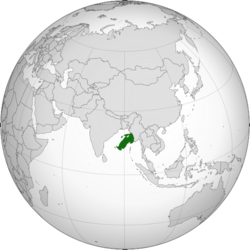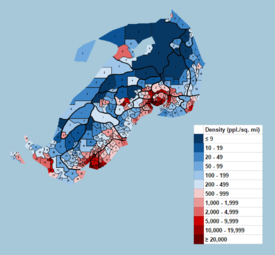Verse:Rttirria: Difference between revisions
(→Health) |
|||
| Line 175: | Line 175: | ||
===Health=== | ===Health=== | ||
Rttirria has a life expectancy of 76.4 years for males and 77.6 years for females, respectively ranking 35th and 80th [[w:List of countries by life expectancy|in the world]]. Though one of the highest in Southeast Asia, it is moderately low among developed countries, especially considering the Rttirrian people's generally healthy diet. Possible reasons put forth include the general unwillingness of many Rttirrians to seek medical treatment, the prevalence of violent confrontations to resolve conflicts, and relatively high crime in much of the country. | Rttirria has a life expectancy of 76.4 years for males and 77.6 years for females, respectively ranking 35th and 80th [[w:List of countries by life expectancy|in the world]]. Though one of the highest in Southeast Asia, it is moderately low among developed countries, especially considering the Rttirrian people's generally healthy diet. Possible reasons put forth include the general unwillingness of many Rttirrians to seek medical treatment, the prevalence of violent confrontations to resolve conflicts, and relatively high crime in much of the country. | ||
===Urbanization=== | ===Urbanization=== | ||
Revision as of 19:58, 8 August 2019
Rttirria
Rttirritteku |
||
|---|---|---|
| Capital | Iharnara | |
| Largest city | Efunari | |
| Official languages | Rttirri | |
| Spoken languages |
Rttirri, Burmese, Gaju, other indigenous languages | |
| Ethnic groups |
77.4% Rttirri 7.4% Burmese 6.9% Other Asian 5.6% White/Black/Latin American 2.7% Other Rttirrians | |
| Religion |
70.1% Hinduism 11.2% Buddhism 4.6% Christianity 2.3% Islam 0.3% Judaism 1.8% others 9.9% unaffiliated | |
| Demonym | Rttirrian | |
| Government |
Liberal democratic presidential republic | |
| Area | 119,595.59 sq mi (309,751 km2) | |
| Population • 2015 estimate • 2010 census • Density |
58,182,131 55,247,900 484.97/sq mi (187.25/km2) | |
| GDP (PPP) • Total • Per capita |
2015 estimate US$1.666 trillion US$28,627 | |
| Gini (2010) |
35.8 medium | |
| HDI (2014) |
▲ 0.863 very high · 30th | |
| Currency | Nakku (Ṉ) (RTN) | |
| Time zone | UTC+6 | |
| Drives on the | right | |
| Internet TLD | .rt | |
Rttirria (English: /ˈtɪəriə/, Rttirri: [ʈʼiɻitʼøku] Rttirritteku) is a country in Southeast Asia. Covering an area of about 120,000 sq mi (310,000 km2), Rttirria is the 70th largest country on Earth, immediately after Poland. With a population of over 58 million people as of 2015, it is also the 24th most populous country, after Italy. Rttirria's capital is Iharnara, which is its fourth largest city by population at 1.5 million people; its largest city is Efunari, with 4.2 million. It is a presidential republic and liberal democracy with one of the highest Human Development Index and GDP per capita ratings in Southeast Asia.
Sharing a land border with Myanmar on the northeast, Rttirria has a diverse topography. The population is heavily concentrated in metropolitan areas along the southeastern coast; most of the northern part of the country, especially in the Rsewakai mountain range, is very sparsely populated. Most of the population speaks Rttirri, but sizable minority communities speak other indigenous and immigrant languages. The largest religion is Hinduism; other significant minority religions are Buddhism, Islam, Christianity, and atheism.
Rttirria is divided into 27 provinces, each of them—except Martirtu—themselves divided into counties. Rttirria remained a developing country well into the 20th century, punctuated by waves of political riots—especially in Iharnara—in the 1960s and 1970s. Since then, its economy and political standing have blossomed into those of a middle power, propelled by the government's investment in free education, business, technology, tourism, and free trade.
Etymology
The native name for Rttirria is Rttirritteku, which simply means "the Rttirri homeland" or "the Rttirri nation". The suffix -tteku is also used in various other names for countries in Rttirri, particularly in Southeast Asia. The etymology of Rttirri is unknown, but is recorded in inscriptions dating back to the 14th century. One commonly purported origin of the name is rtti-rri (lit. "mongoose-like"), but this is believed to be a false etymology—the name Rttirri predates the adjectival suffix -rri, at least in written text. Originally -rrirai ("to resemble") was used to derive adjectives from nouns, and only later was it simplified to -rri. In fact, the Eastern dialects of the Rttirri language pronounce the two words differently: Rttirri [ʈʼɨɻɨ] vs. rtti-rri [ʈʼɨɻi].
Geography
Physical geography
With an area of 119,595.59 sq mi (309,751 km2), Rttirria is situated on a peninsula in Southeast Asia, on the Indian tectonic plate. It borders Myanmar to the southwest and jutting into the Bay of Bengal toward India and Sri Lanka. The country has a diverse topography, ranging from dense tropical rainforest and swamps—particularly near the border with Myanmar—to the alpine Rsewakai Mountains in the center and north, steep cliffs and meadows in the southwest, and the volcanic island province of Rseperupu.
Political divisions
Rttirria is divided into 27 provinces; all of them were historically their own kingdoms except for West and East Warakitasa, which were a single kingdom and then a single province. They were divided in the late 19th century by the British for greater ease of governance, along a crude north-south line that separated numerous cities and towns. Although the provinces have distinct regional identities, cultures, and dialects of the Rttirri language, the nation has maintained a fairly consistent identity since the 14th century, when Indian colonists and traders brought the 26 kingdoms into closer contact with one another. The provinces vary widely in population, from West Warakitasa (10.2 million, 17.6% of the national population) to Wimichimau (50,300, 0.09%).
Notably, the capital city of Iharnara does not constitute its own province, instead being located along the southern coast of Akkakau; if it did, it would be ranked 12th in population and first in population density. Its infrastructure, business, education, and other functions are handled by the county and province, just like those of any other city. There is some support for splitting the city off into the 28th province of Rttirria, particularly by westerners who see its positioning in an Eastern province as a form of Eastern privilege, but no organized movement has materialized so far.
Each province is divided into counties—ranging from the 3 counties of Wimichimau to the 44 of Miwikipu—except for Martirtu. The counties have no longform names, being denoted simply with numbers. Many counties are coextensive with city boundaries, such as Akkakau County 12 (Iharnara), West Warakitasa County 5 (Efunari), and Kikai County 10 (Kikai).
In 1975, Martirtu's government consolidated its 8 counties into one per a ballot measure. Arguments presented by proponents of the consolidation measure included greater bureaucratic efficiency, banding together to serve as a check on the power of the federal government in Iharnara, ethnic homogeneity, and little cultural and linguistic diversity compared to other provinces; the resolution passed by a sizable margin. Other county consolidation measures have been placed on ballots in Urtuki, Yenesni, and Wimichimau, but none of these measures has passed.
Demographics
| Census | Pop. | %± | |||
|---|---|---|---|---|---|
| 1890 | ~9,820,000 | — | |||
| 1930 | 23,977,259 | 244.2% | |||
| 1940 | 28,844,642 | 20.3% | |||
| 1950 | 33,402,095 | 15.8% | |||
| 1960 | 40,683,752 | 21.8% | |||
| 1970 | 41,538,111 | 2.1% | |||
| 1980 | 39,419,668 | −5.1% | |||
| 1990 | 42,336,724 | 7.4% | |||
| 2000 | 49,152,936 | 16.1% | |||
| 2010 | 55,247,900 | 12.4% | |||
| 2015 | 58,182,131 | 5.3% |
Ethnicity
Rttirria is fairly ethnically homogeneous among Southeast Asian nations. Its dominant ethnic group, the Rttirri people, make up 77.4% of the population as of 2015 population estimates, though this percentage is declining. The remaining 22.6% of the population are considered ethnic minorities, and consist of Burmese ethnic groups (7.4%); other Asian peoples from East, Southeast, South, and West Asia (6.9%); non-Asian (5.6%); and of other native cultures on the Rttirrian peninsula (2.7%).
Asian people who are neither Rttirri, other native Rttirrian, or Burmese are of diverse origins, primarily from China, South Korea, Thailand, the Philippines, India, Pakistan, Syria, and Iraq. Likewise, non-Asians hail from many other countries around the world, principally the United States, the United Kingdom, Nigeria, Egypt, Somalia, and Serbia and other former Yugoslav countries.
Health
Rttirria has a life expectancy of 76.4 years for males and 77.6 years for females, respectively ranking 35th and 80th in the world. Though one of the highest in Southeast Asia, it is moderately low among developed countries, especially considering the Rttirrian people's generally healthy diet. Possible reasons put forth include the general unwillingness of many Rttirrians to seek medical treatment, the prevalence of violent confrontations to resolve conflicts, and relatively high crime in much of the country.
Urbanization
The population is heavily concentrated in metropolitan areas along the southeastern coast, such as those surrounding the cities of Efunari, Iharnara, Kikai, and Chukkapati. Most of the northern part of the country, especially in the Rsewakai Mountains, is very sparsely populated, the result of geographical isolation, higher altitudes, and historically lower industrial development.
Rttirria has seen moderate urbanization during its history, albeit not to the extent of many other countries. In much of eastern Rttirria, the populations of large urban centers such as Iharnara, Ttyami, and Umairri have been declining for decades due to high crime, protests and riots, deprived post-industrial economies, and political corruption; their inhabitants have been moving to western and northern Rttirria and into rural areas of the east, such as in northern Yenesni, southern Rtuha, and Miwikipu.
The populations of the ten largest cities of Rttirria are as follows:
| Rank | City | Province | Region | Pop. (2015) | Pop. (2010) | %± |
|---|---|---|---|---|---|---|
| 1 | Efunari | West Warakitasa | West | 4,519,216 | 4,320,071 | 4.6% |
| 2 | Chukkapati | Hima | West | 2,100,631 | 1,950,903 | 7.7% |
| 3 | Tettufane | Namihafapu | North | 1,604,188 | 1,349,193 | 18.9% |
| 4 | Iharnara (capital) | Akkakau | East | 1,592,079 | 1,603,190 | −1.3% |
| 5 | Fukanucha | Fukanucha | East | 957,825 | 955,194 | 0.3% |
| 6 | Ttyami | Ttyami | East | 661,935 | 724,922 | −8.7% |
| 7 | Aiti | East Warakitasa | West | 596,925 | 578,154 | 3.3% |
| 8 | Umairri | Umairri | East | 504,559 | 530,615 | −4.9% |
| 9 | Kikai | Kikai | East | 451,812 | 423,134 | 6.8% |
| 10 | Rraiwafa | Hima | West | 393,046 | 356,490 | 10.3% |
Culture
Snenuppais

Rttirri's trademark art form is the snenuppai, which translates literally as "little family" and consists of a three-panel comic, arranged from top to bottom. Snenuppais are used for many serious and comedic purposes in the present day, such as for political cartoons in newspapers, illustrations in children's books, pamphlets at religious ceremonies and in many Rttirri editions of Hindu sacred texts, and instructions on appliances.
The origins of snenuppais are unknown, but short visual stories have been found in etchings in stone, clay, and petrified wood all over western Rttirria, some of them dating back to at least the 8th century CE. These visual stories vary in length, but usually consist of between one and five "panels", which are usually arranged vertically. They were used for a range of purposes, including recording the histories of families, cities, and kingdoms; keeping track of inventories and debts; predicting the future; and allowing newly married couples to write out their wedding vows.
Perhaps most notably of all, many of these early comics, even those used to tell narratives, used blocks of symbols intended to convey speech and narration. Linguists have analyzed these symbols and found no meaningful correspondence between them and any known stage of the Rttirri language, but because of the non-literal nature of many symbols used (for example, a drawing of a head shaking was sometimes used to signal negation), it is hypothesized that if Rttirria had been isolated from Arab and Indian peoples, these symbols could have eventually evolved into a logographic writing system like that of Chinese or the Mayan languages.
Cuisine
Rttirrian cuisine is similar to that of other Southeast Asian nations, with an emphasis on such staples as rice, coconuts, fruits, vegetables, nuts, and fragrant spices and herbs. Herbs and spices such as lemongrass, ginger, and bird's eye chili are also used as garnishes. Candlenuts are a common source of oil for frying, though the seeds are toxic when eaten raw. Borneo tallow nuts (in the Shorea genus) are an occasional source of protein.
Fruits are used in many dishes, including the tamarind, durian, banana, pomegranate, plum, and sugar-apple. They are incorporated both in their entirety and for the flavors of their juice, and are used in dishes ranging from ordinary curries and stir-fries to pastries and dumplings, even being combined freely with hot spices such as chilis. As a result, many Rttirrian dishes exhibit the unusual flavor combination of sweet and spicy.
Music
The modern Rttirrian music industry is centered in major cities; Efunari is the foremost hub for pop music, while Tettufane is better known for alternative and indie music. Solo artists and bands perform many different Western genres, such as rock, hip hop, electronica, heavy metal, punk rock, R&B, and avant-garde. Artists may incorporate heavy compositional and instrumental elements of Rttirrian traditional music or none at all.
Progressive rock has remained prominent in Rttirria for decades after its decline in popularity in Europe and North America; Rttirria is a top touring destination for Western progressive rock artists, and native artists have continued to evolve the genre stylistically, experimenting with different unconventional song structures, lyrical topics, and instrumentation. Bluegrass has also enjoyed popularity in Rttirria due to its complexity and resemblance to the nation's traditional music, and the banjo has become a reasonably widely used instrument in other genres.


